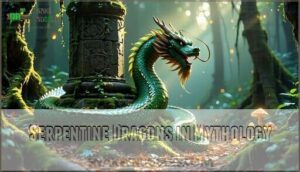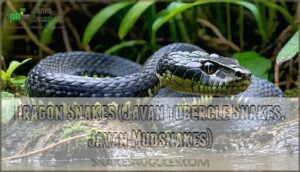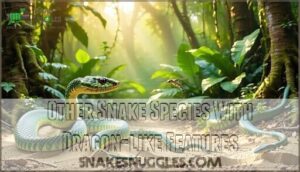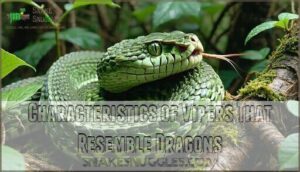This site is supported by our readers. We may earn a commission, at no cost to you, if you purchase through links.
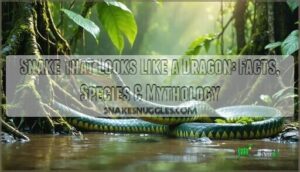 Deep in Southeast Asia’s wetlands, a creature slithers through the mud that looks like it escaped from a fantasy novel. The dragon snake earned its name honestly—three rows of rough, keeled scales run down its back like armor plating, giving it an appearance more reptilian monster than common serpent.
Deep in Southeast Asia’s wetlands, a creature slithers through the mud that looks like it escaped from a fantasy novel. The dragon snake earned its name honestly—three rows of rough, keeled scales run down its back like armor plating, giving it an appearance more reptilian monster than common serpent.
This rare species isn’t alone in resembling mythical beasts. From the spiny bush viper’s blade-like scales to flying snakes that glide between trees, nature has created its own collection of dragon-like serpents that rival anything from legend.
Understanding these fascinating snakes reveals how reality and mythology have always intertwined, each inspiring the other across centuries of human storytelling.
Table Of Contents
- Key Takeaways
- Dragon Snake Biology
- Serpentine Dragons in Mythology
- Designing Serpentine Dragons
- Real-Life Snakes That Resemble Dragons
- Creating Fictional Serpentine Dragons
- Frequently Asked Questions (FAQs)
- What are the snake like dragons called?
- Are dragon snakes poisonous?
- What dragon is like a snake?
- What kind of viper looks like a dragon?
- What snake species resemble mythical dragons?
- How do snakes achieve a dragon-like appearance?
- Are dragon-like snakes found in specific regions?
- What role do dragon-resembling snakes play in culture?
- Do any snakes have dragon-like features naturally?
- Are dragon snakes legal to own as pets?
- Conclusion
Key Takeaways
- The dragon snake (Xenodermus javanicus) earns its mythical name from three rows of raised, keeled scales running down its back that create a spiky, armor-like appearance, though it’s completely non-venomous and relies on defensive behaviors like body stiffening instead of venom.
- Several real snake species bear striking dragon-like features—including the spiny bush viper’s blade-like scales and paradise flying snakes that glide up to 100 yards by flattening their bodies—demonstrating how nature has created its own collection of serpents that rival mythological creatures.
- Dragon snakes require extremely precise captive care with 70-95% humidity, stable temperatures of 72-77°F, and a diet of small fish, frogs, and tadpoles, making them notoriously challenging pets that are highly stress-prone and don’t tolerate handling well.
- The biological and mythological connection between real serpents and dragon legends runs deep across cultures—from Asian flying snakes inspiring wingless, undulating dragons to the evolutionary adaptations of keeled scales and triangular heads that mirror the armor-plated beasts of ancient folklore.
Dragon Snake Biology
You’ll find the dragon snake’s biology is as unique as its appearance. Understanding their physical traits, habitat needs, diet, behavior, and health requirements helps you appreciate why these snakes earned their mythical name.
Let’s examine what makes Xenodermus javanicus such a distinctive species.
Physical Characteristics of Dragon Snakes
You’ll notice dragon snakes (Xenodermus javanicus) display three distinctive rows of rough, keeled scales running down their backs, creating a spiky, dragon-like dorsal morphology. Their body coloration ranges from dark gray to nearly black, with subtle scale iridescence that shifts in different lighting.
These dragon snake characteristics include a triangular head shape broader than the neck and size variations usually between 2 to 2.6 feet in length, with lighter underbellies contrasting sharply against their dark backs.
These snakes are native to Southeast Asia and nearby islands.
Habitat and Environmental Requirements
Dragon snakes thrive in Southeast Asia’s swampy forests and wetland areas, where environmental conditions stay consistently warm and wet. You’ll need to replicate their natural Dragon Snake Habitat carefully, focusing on these critical elements:
- Humidity Levels: Maintain 70-95% to prevent dehydration
- Temperature Gradients: Keep stable at 72-77°F throughout the enclosure
- Soil Composition: Use sphagnum moss over soft substrate near Water Sources
Enclosure Design must account for their semi-fossorial nature, providing dense cover and access to shallow water.
These snakes, also known as the Javan tubercle snake, are relatively rare in the wild. Habitat loss from deforestation makes captive care especially important for conservation awareness.
Diet and Feeding Habits
In captivity, you’ll quickly discover that dragon snakes are notoriously finicky eaters, refusing meals when stressed and accepting only specific prey types like small fish, frogs, and tadpoles.
Their Prey Preferences lean heavily toward aquatic prey, mirroring their Hunting Behavior in the wild where they ambush amphibians near water.
Establishing a reliable Captive Feeding routine takes patience—offer two small fish or one frog every seven to ten days to meet their Nutritional Needs without overfeeding.
Handling and Temperament
You might expect a snake with dragon-like spikes to have a bold personality, but dragon snakes are actually fragile, stress-prone creatures that don’t tolerate being picked up well. When you attempt to pick them up, their defensive postures kick in, and these exotic pets exhibit captive behavior like body stiffening or refusing food for days.
Responsible interaction requires understanding these temperament factors:
- They’re solitary and prefer minimal contact.
- Stress reduction means avoiding unnecessary interaction.
- Their bite, though non-venomous, causes pain.
- Frequent interaction disrupts their natural snake behavior.
Health and Longevity
With the right setup, your dragon snake’s lifespan stretches beyond a decade, but their delicate constitution means small mistakes can shorten it dramatically. Lifespan factors like proper diet and stable conditions determine whether your dragon snake health thrives or declines rapidly.
Common ailments stem from environmental impact—humidity below 70% triggers respiratory health problems, while dietary needs go unmet when stress disrupts feeding. Captive care demands vigilance against skin infections and parasites, the most frequent health issues.
Serpentine Dragons in Mythology
Serpentine dragons have slithered through human imagination for thousands of years, appearing in myths from ancient China to medieval Europe. These legless, snake-bodied dragons evolved differently across cultures, shaped by local serpents and the stories people told about them.
You’ll find that understanding this mythological foundation helps explain why real snakes with spiky scales or unusual features capture our attention today.
Historical Depictions of Serpentine Dragons
Throughout history, serpentine dragons have slithered through mythology and art with undeniable power. Ancient Serpent Gods like the Mesopotamian Tiamat and the Greek Python embodied chaos and divine strength, their snake-like bodies coiling through creation myths.
Medieval Dragon Art depicted these creatures as fearsome adversaries in illuminated manuscripts, their elongated forms twisting around knights and castles. During the Renaissance, Dragon Imagery evolved with more anatomical precision, artists studying real snake species to improve their mythical beasts’ authenticity.
Eastern Dragon Evolution followed a different path—Chinese and Japanese dragons retained their serpentine grace, lacking wings yet flying through clouds, symbolizing wisdom rather than destruction.
These Cultural Symbolism variations reveal how dragon snake characteristics mirror humanity’s complex relationship with actual snake behavior, transforming fear and fascination into enduring mythological creatures.
Evolution of Dragon Mythology
Dragon mythology traces its myth origin back roughly 75,000 years to South Africa, with the Sumerian "ušum-gal" (big snake) appearing over 4,000 years ago. Physical depiction transformed gradually—serpentine forms gained legs and wings between 900 BCE and 1700 AD, while fire-breathing emerged in medieval Europe.
Cultural symbolism varied: Eastern dragons symbolized wisdom and rain, Western ones destruction. Geographic adaptation followed human migration from Africa through Asia to Europe, creating regional variations.
Modern legacy persists in media, though literal belief faded by the 18th century. Dragon snakes—dragonlike snakes with unique physical traits—echo this evolutionary history, their spiky scales mirroring mythical ancestors’ unique dragon snake features.
Inspiration From Asian Flying Serpents
Asian flying serpents—real snake species like Chrysopelea—inspired dragon myth origins across Southeast Asia. These gliding serpents flatten their bodies and leap between trees, embodying flying snake lore that shaped serpent symbolism in regional mythology.
Their aerial prowess influenced artistic interpretations of wingless, undulating dragons in Chinese and Thai traditions, demonstrating profound cultural significance.
Dragon snakes (Xenodermus javanicus) share these mythical connections through their unique dragon snake features—raised, keeled scales echoing legendary creatures—linking biology to folklore.
Modern Interpretations of Serpentine Dragons
Contemporary storytellers have reimagined serpentine dragons as sleek, wingless forces of nature—blending ancient mythology with modern fantasy design to create creatures that feel both timeless and strikingly new.
Pop-culture dragons now showcase evolving designs through films, games, and literature, where dragon adaptations reflect modern symbolism of transformation and power.
Future depictions draw from real snake species like Dragon Snakes (Xenodermus javanicus), whose spiky scales and reptile behavior bridge mythology with authentic snake behavior, creating believable yet fantastical creatures.
Designing Serpentine Dragons
When you picture a dragon in flight, you’re really engineering a biological impossibility—unless you borrow from the creatures that already mastered serpentine aerodynamics. Creating believable serpentine dragons means understanding the physics that keep long, legless bodies airborne and the anatomical trade-offs required for flight.
Let’s break down the key design elements that separate fantasy from functional dragon anatomy.
Size and Flight Limitations
When you’re designing a creature that defies gravity, physics becomes the biggest problem. Serpentine dragons face serious hurdles: their elongated snake morphology and body mass limit gliding distance without substantial muscle strength. Here’s what you’ll need to think about:
- Average Size – Larger dragons require exponentially more power for lift
- Skeletal Structure – Hollow bones reduce weight but compromise strength
- Scale Aerodynamics – Smooth surfaces improve airflow efficiency
- Unique Physical Traits and Adaptations – Specialized dragon snake characteristics like reinforced ribs support gliding membranes
Understanding snake anatomy helps you balance these competing demands for believable flight.
Inspiration From Flying Snakes and Lizards
Nature already solved the puzzle of serpentine flight, and you’ll find your best blueprints in the rainforests of Southeast Asia and the gliding mechanics of Draco lizards. Flying snakes flatten their ribs to create makeshift airfoils, while Draco lizards deploy wing-like flaps for predator evasion. These reptiles showcase arboreal adaptations shaped by evolutionary pressures and biomechanical constraints.
- Chrysopelea paradisi flattens its body into a pseudo-concave wing for controlled glides
- Draco volans extends elongated ribs covered in thin membranes to glide between trees
- Both species demonstrate how snake morphology and unique physical traits enable gliding mechanisms in dragon snakes and similar reptiles.
Launch Mechanisms and Gliding Capabilities
Once your serpentine dragon achieves the right body shape and aerodynamic structure, you’ll need to understand how it actually gets airborne and stays there. Launch techniques mirror those of flying snakes, which use J-shaped loops and explosive muscular propulsion from tree branches.
These launch mechanisms provide evolutionary advantages through predator evasion and expanded flight range. Your dragon maintains aerial stability by undulating its body in controlled waves, creating lift through active locomotion.
This weaving motion has dual purposes as both a defensive mechanism and environmental adaptation, allowing sustained glides across forest canopies—a unique adaptation that transforms threat displays into functional flight.
Streamlined Body Shape and Aerodynamics
Your dragon’s body must slice through air with minimal resistance, much like how a falcon tucks its wings during a dive to heighten speed. Drawing inspiration from the dragon snake’s (scientific name: Xenodermus javanicus) natural streamlining, your design should minimize scale friction while maintaining structural integrity.
Their keeled scales and undulation mechanics offer evolutionary advantages for both aquatic agility and burrowing efficiency—environmental adaptations that translate surprisingly well to aerial movement, creating unique adaptations for sustained gliding.
Lightweight Scales and Hollow Bones
To conquer the skies, a serpentine dragon needs a skeletal framework that mirrors the hollow-boned engineering of modern birds—where every gram saved translates directly into extended flight duration and maneuverability. This bone pneumatization creates skeletal adaptations that reduce overall mass without sacrificing strength, much like the dragon snake anatomy demonstrates with its flexible vertebrae. The scale composition must balance protection with weight reduction, where keeled scales provide structural rigidity while remaining surprisingly light.
Consider these evolutionary advantages for your design:
- Hollow bone chambers filled with air sacs reduce skeletal mass by 40-60%
- Thin, overlapping scales minimize armor weight while maintaining flexibility
- Reinforced wing membranes supported by lightweight keratin struts
- Calcium-rich but porous bone structure provides strength without density
- Spiky scales along the spine serve as aerodynamic stabilizers during flight
These unique adaptations mirror environmental adaptations seen in nature, where form follows function for maximum aerial efficiency.
Real-Life Snakes That Resemble Dragons
While dragons might be pure fantasy, nature has created snakes that come remarkably close to resembling these mythical beasts. From rough, keeled scales that look like armor to triangular heads and dark coloration, several snake species bear striking dragon-like features.
Let’s explore the real serpents that could have inspired dragon legends throughout history.
Dragon Snakes (Javan Tubercle Snakes, Javan Mudsnakes)
Dragon snakes (Xenodermus javanicus), also called Javan tubercle snakes, inhabit Southeast Asia’s wetlands. Their signature rough keeled scales are arranged in three dramatic rows. You’ll recognize their triangular heads and dark, almost black bodies that stretch about 50 cm.
These nocturnal creatures remain hidden during the day in muddy burrows. When threatened, they exhibit defensive behaviors such as body stiffening and emitting a musky odor.
Captive care for dragon snakes is challenging. They are picky eaters, requiring a diet of frogs and tadpoles, and need precise humidity levels between 70-90%.
Conservation threats include wetland destruction across their native range.
Other Snake Species With Dragon-like Features
Beyond the dragon snake, you’ll find several dragonlike snake species with striking features. The Spiny Bush Viper (Atheris hispida) displays sharp, elevated scales covering its body, especially prominent on the head and neck. The Paradise Flying Snake (Chrysopelea paradisi) achieves Flying Snake Gliding up to 100 yards by flattening its body into a ribbon shape. Horned Adder Camouflage relies on distinctive horn-like scales above the eyes. Arboreal Bush Vipers inhabit central Africa’s rainforests with vertical pupils and neurotoxic venom.
Key features include:
- Vibrant Viper Scale Patterns in green, blue, yellow, or red
- Maximum lengths reaching 30 inches for venomous snake species
- Specialized hunting adaptations like heat-sensing pits
- Dramatic snake appearance modifications for defense displays
Characteristics of Vipers That Resemble Dragons
Vipers captivate observers with their keeled scales that jut outward like armor plating, their triangular heads that mirror the fierce profiles of mythical beasts, and their slow, deliberate movements that seem to carry the weight of ancient legends.
Their Venom Delivery systems include heat-sensing pits for precision Hunting Strategies, while Camouflage Patterns break up their silhouettes in dense vegetation.
Bush Vipers showcase stunning Scale Morphology with Arboreal Adaptations like prehensile tails, making these dangerous snakes both beautiful and formidable in snake classification.
Pictures and Videos of Dragon-like Snakes
When you scroll through images and clips of dragon snakes, bush vipers, and other serpentine species online, you’ll notice their spiky scales, triangular heads, and coiled postures look like they were plucked straight from a fantasy novel. These Stunning Imagery captures showcase rare encounters with species like dragon snakes, whose keeled scales shimmer with subtle iridescence under proper lighting.
Visual identification becomes easier when you observe behavior showcases revealing their stiff defensive postures and nocturnal hunting patterns, though such footage raises legitimate captivity concerns among reptile experts.
Creating Fictional Serpentine Dragons
If you’re building a serpentine dragon from scratch, you’ll want to ground your creation in both myth and biology. The key is blending the otherworldly appeal of ancient legends with the physical realities that make a creature feel alive.
Here’s how you can craft a dragon that’s both imaginative and believable.
Drawing Inspiration From Mythology and Nature
Mythology hands you the blueprint—ancient serpents that guard treasures and rule the skies—while nature provides the engineering, from the sidewinding glide of chrysopelea to the iridescent armor of Xenodermus javanicus. You’ll find mythological archetypes like Asian nagas offering cultural interpretations, while dragon snake behavior—stiffening bodies, camouflage, defensive mechanisms—gives your creation biological grounding. Blend natural symbolism with artistic license to craft evolutionary fantasy that feels authentic:
- Study dragon snake physical characteristics like keeled scales and triangular heads
- Examine cultural interpretations across Asian serpent mythology
- Apply defensive mechanisms from real species to fictional predators
- Balance mythological archetypes with nature’s proven adaptations
Designing Unique and Believable Dragon Species
Building a believable dragon species requires more than stacking mythical features—you need internal logic that connects anatomy, behavior, and habitat into something that could actually survive in the wild. Consider how keeled scales might protect vulnerable areas, or how scale variation affects movement through different terrain.
Study dragon snake physical characteristics—triangular heads, raised dorsal ridges—and apply evolutionary adaptations that make sense. Your creature needs behavioral ecology that explains hunting patterns, dragon lifecycles tied to reproduction cycles, and unique abilities grounded in anatomy inspiration from real snake species, not just spectacle.
Considering Environmental and Biological Factors
Environment shapes survival—humidity levels, temperature ranges, prey availability—and every biological detail must answer to that reality. Dragon snake habitat demands wetland conditions with 70-90% humidity, showing how climate change and habitat loss directly threaten species viability.
When designing fictional serpents, ground their biology in ecological truth:
- Dietary needs must match available prey in their range
- Defense mechanisms should reflect actual predator threats
- Captive breeding success depends on replicating native conditions
- Dragon snake conservation status reminds us that habitat conservation determines survival
Creating a Rich History and Culture for Serpentine Dragons
Once you’ve locked in the biology and environment, it’s time to weave legends, languages, and customs that make your serpentine dragons feel like they’ve existed for centuries. Draw from Dragon Culture Origins and Serpentine Dragon Beliefs to establish how these nonvenomous snake species evolved into revered creatures. Consider Dragon Social Structures—do dragon snakes live in solitary hierarchies or communal nests? Build Dragon Rituals around molting seasons, territorial displays mirroring real snake behavior and habits, and Dragon Art Forms etched into scales.
- Ancestral migration stories linking dragon snakes to ancient wetlands
- Symbolic scale patterns representing clan lineage and status
- Ceremonial hunts honoring prey species like frogs and fish
- Oral traditions explaining their spiky, keeled dorsal ridges
- Artistic carvings depicting serpentine dragon mythology across Southeast Asian landscapes
Frequently Asked Questions (FAQs)
What are the snake like dragons called?
In mythology, serpentine dragons go by names as varied as the cultures that created them—from the Chinese lóng to European wyrm and the feathered Mesoamerican Quetzalcoatl.
But if you’re asking about real reptiles, you’re talking about dragon snakes (Xenodermus javanicus), also called Javan tubercle snakes, roughbacked litter snakes, or Javan mud snakes. These Southeast Asian species earned their mythical nickname from three rows of raised, keeled scales running down their backs, giving them a distinctly dragon-like silhouette. Their dark, iridescent bodies and spiky texture make them look like they crawled straight out of folklore, even though they’re harmless, nocturnal creatures preferring swamps and rice paddies. The name "dragon snake" captures both their fierce appearance and the ancient human impulse to see mythical beasts in the natural world.
Are dragon snakes poisonous?
No, dragon snakes aren’t venomous or poisonous. These harmless, non-venomous snakes rely on defensive behaviors like body stiffening and musky odors instead of venom delivery. You won’t experience snake bite effects from these shy creatures.
What dragon is like a snake?
Serpentine dragons from Asian mythology embody the snake-like dragon archetype. These mythical creatures feature elongated, limbless bodies with keeled scales and iridescence, weaving through clouds and water with fluid grace.
They symbolize wisdom and power across East Asian cultures.
What kind of viper looks like a dragon?
Looking for something truly otherworldly? The African bush viper, specifically Atheris hispida, stands out with its keeled scale morphology creating a bristly, hairy look that mimics a dragon’s texture.
These venomous snakes use impressive camouflage techniques in their bush viper habitat, blending into dense African bush vegetation while displaying color variations—from green to yellow—that amplify their mystical appearance despite their potent venom.
What snake species resemble mythical dragons?
Several snake species mirror the appearance of mythical dragons through their distinctive features.
The dragon snake (Xenodermus javanicus), also called the Javan tubercle snake, stands out with its three rows of raised, keeled dorsal scales that resemble a dragon’s spiny armor. Its dark coloration, triangular head, and iridescent sheen create a mystical appearance that captivates reptile enthusiasts and mythology lovers alike.
How do snakes achieve a dragon-like appearance?
Nature’s own artisans have crafted certain serpents with raised, keeled scales that evoke ancient armor. Scale morphology in Xenodermus javanicus creates pronounced ridges along the body, while coloration patterns of dark browns and blacks intensify the effect.
Their triangular head, distinctive body proportions, and defensive postures—stiffening when threatened—complete the transformation from ordinary snake to living myth.
Are dragon-like snakes found in specific regions?
You’ll find the most recognizable dragon-like snakes, particularly the Javan dragon snake, in Southeast Asia’s humid lowlands.
Their geographic distribution spans Malaysia, Thailand, Indonesia’s Java, Sumatra, and Borneo, where habitat-specific adaptations thrive in wetlands, rice paddies, and rainforests at elevations between 1,600 and 3,600 feet.
What role do dragon-resembling snakes play in culture?
Throughout history, you’ll discover dragon snakes carrying mythological significance across Southeast Asian cultures, where they’ve symbolized strength and mysticism. Their folklore influence appears in artistic depictions and religious context, linking these exotic pets to ancient beliefs.
Cultural symbolism transforms the dragon snake into a living embodiment of mythology, bridging nature’s reality with cultural imagination.
The dragon snake stands as a living symbol of myth, blending nature’s reality with the power of cultural imagination
Do any snakes have dragon-like features naturally?
Yes, the dragon snake (Xenodermus javanicus) naturally displays dragon-like features through its three rows of raised, keeled dorsal scales that resemble mythical dragon spikes.
You’ll find this unique reptile in Southeast Asia’s wetlands, where its triangular head shape, dark coloration, and iridescent scale patterns create a striking resemblance to legendary serpentine dragons.
Are dragon snakes legal to own as pets?
You’ll need to check your state’s exotic pet laws before bringing a dragon snake home. Permit requirements vary widely, and the exotic pet trade threatens wild populations, so responsible sourcing matters greatly if ownership is even legal in your area.
Conclusion
Where myth meets mudflat, the snake that looks like a dragon proves nature’s imagination rivals our own. These armored serpents—from the three-keeled dragon snake to the razor-scaled bush viper—didn’t inspire legends by accident. Their prehistoric silhouettes remind us that evolution sometimes sketches the same creatures we dreamed into existence.
Whether you’re studying real species or designing fictional ones, these serpents offer a bridge between scientific wonder and storytelling magic, proving dragons never truly left—they just learned to breathe underwater instead of fire.
- https://en.wikipedia.org/wiki/Echis
- https://palaeomedia.blogs.bristol.ac.uk/2023/03/31/darwinism-and-dragons/
- https://www.bbc.com/future/article/20240208-the-surprising-4000-year-history-of-dragons
- https://www.athensjournals.gr/mediterranean/2018-4-4-1-Khalifa-Gueta.pdf
- https://www.britannica.com/topic/dragon-mythological-creature

